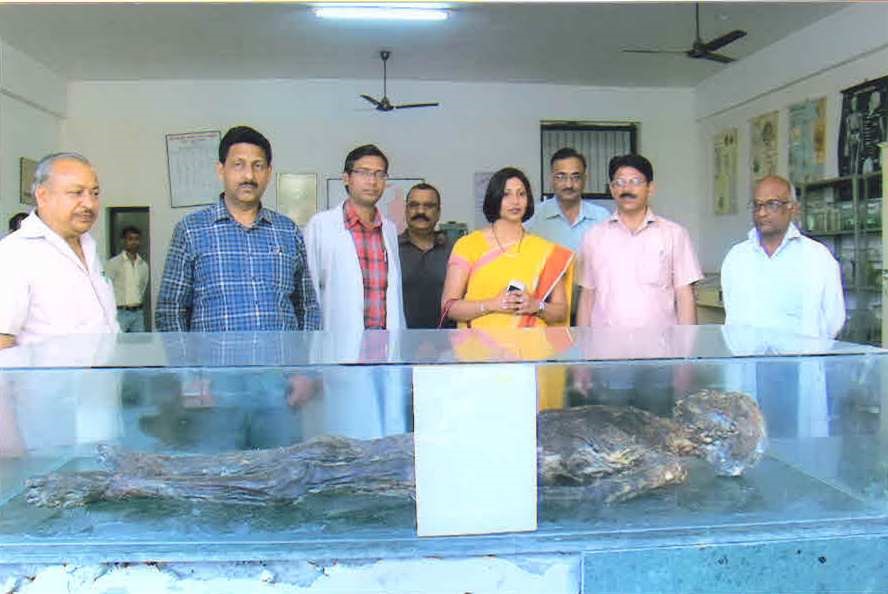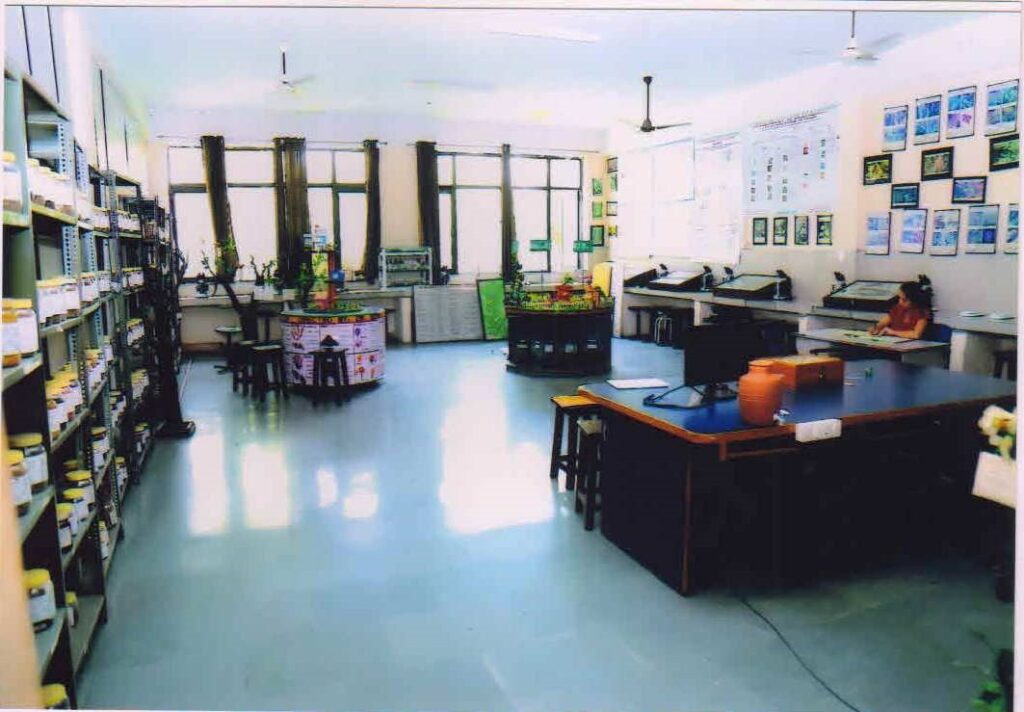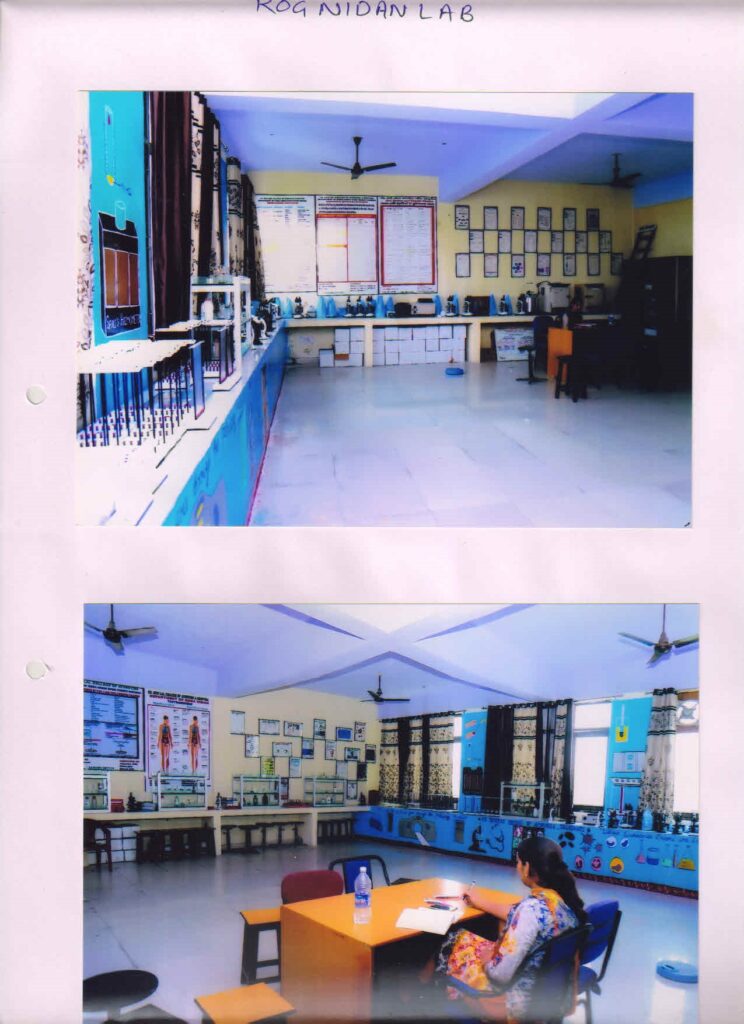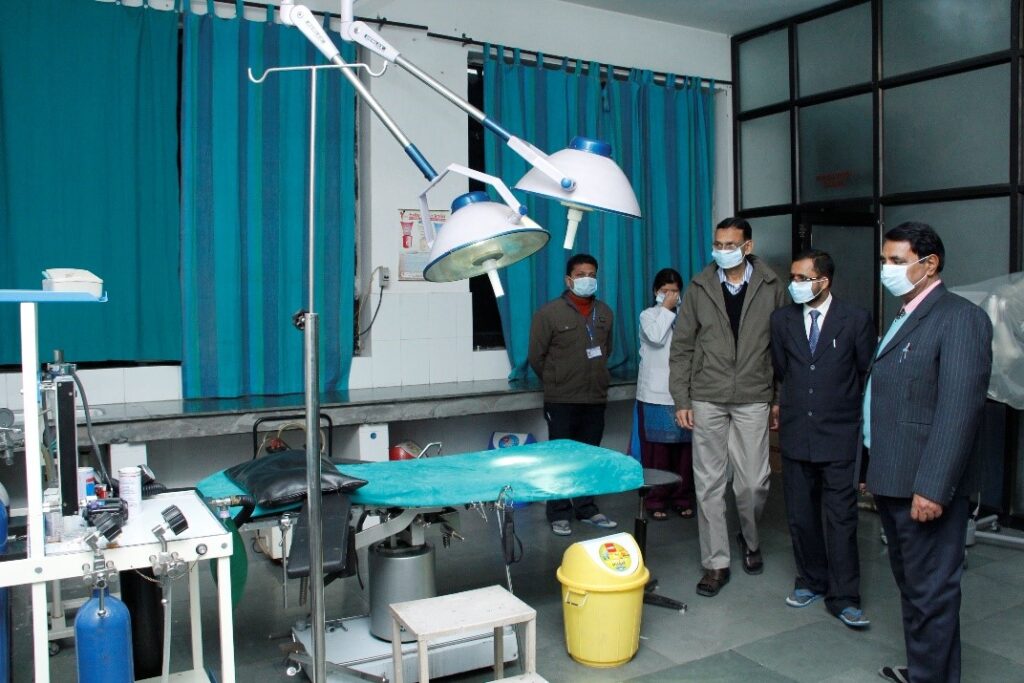Departments of College of Ayurveda
- Dept. of Moulik Siddhant (Basic Principles)
- Dept. of Rachana Sharir (Anatomy)
- Dept. of Kriya Sharir (Physiology)
- Dept. of Dravyaguna (Pharmacology)
- Dept. of Rasa Shastra & Bhaishajya Kalpana (Pharmaceutics)
- Dept. of Agad Tantra & Vyavaharayurveda (Toxicology and medical Jurisprudence)
- Dept. of Swasthvritta (Hygiene & Preventive Medicine including Yoga & Naturopathy)
- Dept. of Rog & Vikriti Vigyan (Diagnostics & Pathology)
- Dept. of Kayachkitsa (Internal Medicine)
- Dept. of Shalya Tantra (Surgery)
- Dept. of Shalakya Tantra (Ophthalmology and Otorhinolaryngology)
- Dept. of Stri Rog & Prasut Tantra (Gynecology and Obstetrics)
- Dept. of Kaumarbhritya (Neonatology and Pediatrics)
- Dept. of Panchkarma.
DEPARTMENT OF SANSKRIT, SAMHITA & MAULIK SIDDHANTA
Ayurveda is ancient science of medicine in India since last Five Thousand Years. Despite of many advances in sciences, Ayurveda is one of the most popular systems of medicine attracting new disciples all over the world. The name of the department itself suggests that it elaborates the basic concepts of diagnosis and treatment. The basic concepts if applied properly and in its authentic way, it leads to the absolute knowledge of disease; which is applied to the newer diseases, too. Darshana Shastra and the scientific base laid by them enable to amplify and implement the concepts. Sanskrit is the basic subject which has been taught to the students through this department. The subject has been included in the curriculum as it is the language of the ancient Ayurvedic texts. It has been looked upon that the students must be well versed with the language so that they would be able to read and absorb the concept explained in these texts.
This department teaches the basic principles like Panchabhoota Sidhant, Tridosha sidhanta, diagnostic & treatment principles of Ayurveda. Padarth vigyana subject is another main subject of this department which provides the basic knowledge about the evolution of the Ayurveda from Indian philosophy. It explains both the darshna shastra and the scientific base.
Samhitas like Charaka, Ashtang Hridaya are also taught to the students. These samhitas guide the students to understand the vital and fundamental concepts of Ayurveda. Samhitas are the basic texts of Ayurveda which includes subject matter of different disciplines of Ayurveda. That means all other branches both clinical and non-clinical including Kaya-Chikitsa, Shalya, Stri rog etc.originates from it. So, this Department deals with the study of Philosophical fundamental approach of Ayurveda as well as the Clinical approach to treat mankind.
Dept. of Rachna Sharir

Anatomy forms firm foundation of whole art of medicine and introduces the student to the greater part of medical terminology.
Hence, the Department focuses on the thorough knowledge of Anatomy gained via theoretical component (lectures) plus practical classes which are performed on Cadavers.
A separate Dissection hall is available. A museum hall which has skeleton, bones, wet specimen, joints and models are available for study.
Dept. of Kriya Sharir
Kriya Sharir is the science that assists in understanding an individual as a whole. As is said-
“Kriya pratipadakam shariram kriya shariram”
Kriya Sharir is the science that is concerned with the study of human body in relation to its physiological norms. Kriya Sharir upskills our knowledge of Prakriti whose analysis is mandatory not only in determining the psychae and physical strength of a healthy individual, but also in diagnosis and treatment of an unhealthy individual.
Dosha (Body humour), Dhatu (Body tissues) and Mala (waste products) are so crucial that they are called Moola or base of a living being because they are responsible for growth, maintenance, functioning and destruction of the body.
“Dosha Dhatu Mala moolam hi shariram” These entities accompanied by Mann, Aatma, Buddhi and Indriya determine the healthy and unhealthy status of behaviour and intellectuality of an individual and are well clarified in the discipline of Kriya Sharir.
Agni, which is the base of all transformations and is one of the entities responsible for sound health, is well illustrated in Kriya Sharir.
The significance of Tripod of life (Aahar, Nidra and Brahmcharya i.e food, sleep and abstinence) and Ojas (immunity) in maintenance health and prevention of diseases are well deciphered in Kriya Sharir.
The subject elucidates the concept of Shatt Kriya Kala, Ashta Aahar Vidhi Visheshaytan (rule of taking meals) etc, a proper understanding of which may prevent the possibility of generation of Vikara (diseases) in individuals. If anyhow the individual reaches the stage of Vikara and treatment becomes necessary, then this pathological condition cannot be properly understood until we have understood the proper physiology.
The modern aspect of Kriya Sharir, i.e. Physiology provides thorough understanding of all vital systems (Digestive, endocrine and nervous etc) of the human body.
Thus Kriya Sharir gives basic knowledge and provides scientific approach to the scholars that enhances the skills required to perform clinical practice and research in the field of Ayurveda.
Dravya Guna Shastra

Identification, properties, deeds and use of all the substances used as food, and medicine for nutrition, health and medical treatment, which are described in scriptures are called Dravya Guna Shastra\Material Science\‘Material Medica’ of Ayurveda.
Under this subject, we get to know about Dravya (drug), properties, functions, therapeutic utility of different dravyas; their classification into various ganas; as well as the modern concepts like botany, pharmacology and pharmacognosy in great detail.
It is said that the vaidya, who has absolute knowledge of Dravyaguna Shastra, is capable of conquesting the field of therapeutics; as without knowledge of aushadha (drug), treatment is certainly impossible.
It has always been difficult for the students to understand the fundamental of this shastra but at Ch. Devi Lal Ayurvedic Institution,
- With the help to excellent faculty, who make all the concepts intresting and easily understandable along with upto date information of the subject;
- With the help of various models, preserved specimens and live plants in the Herbal Garden in the college premices, macroscopic study of plants is made far too accurate as well as intresting for students;
- Along with this, for more and better exposure of the students to plants and their natural environments, trips are lead for time to time to other renowned Herbal Gardens;
- Cultivation as well as taking proper care of plants is done by the students for closely observing them and making botany more innovative;
- Along with macroscopic study, equal emphasis is given to microscopic studies of the plants which increases the interest of students in the field of research;
- Models and surveys conducted by the students on ground levels give them precise knowledge about the adulteration and substitution of various drugs;
- Charts explaining ayurvedic as well as modern concepts make learning easy and contemporary.
These things have proven to be extremely helpful to the students in studying and becoming great doctors.
Department of rasa shastra and bhaishjya kalpana
As per the current syllabus of CCIM, the subject Rasa shastra and bhaishjya kalpana is taught in 2nd year of BAMS.
This is a well established department at CDL College of ayurveda having a museum with about 1000 specimens of various rasa and bhaishjya dravyas. Many models of rasa shastra and BK are also displayed in the museum.
There is a well established pharmacy unit associated with the department in the college campus itself where a large no. Of herbo mineral preparations are made by both classical and modern methods.
In this department students are trained from the very root level of course to make different type of ayurvedic herbal and herbomineral combinations to use for their own patients as well as commercial manufacturing.
The objective of teachers of the department remains to enable the students to identify best quality minerals and train them practically by engaging in various procedures of pharmaceutics.
To keep the students updated with modern pharmaceutical methodologies, time to time visit of various GMP certified, commercial pharmacies is also ensured.
Agad Tantra
Ayurveda is one of the ancient science of life which is practiced for attaining complete health. Ayurveda is comprised of two words Ayu and Veda. Ayu means Span of life and Veda means Knowledge. The description of Ayurveda is more in Atharva Veda and is rendered as upveda of Atharva veda. The systemic study of Ayurveda is divided into eight branches. The Agad Tantra is one of the eight branches into which ayurveda medicine is traditionally divided. Literally gada means a disease and agada means any agent which makes the body free from disease, however the term Agad is used specifically for the branch of medicine dealing with toxicology, the description of the different types of poison and their antidotes. Agad Tantra is defined as the branch of medical science which deals with poisons with references to their sources, characters and properties, the symptoms which they produce, the lethal dose the nature of total results the remedial measures which should be employed to combat their actions of effects, the methods of their detection and estimation and autopsy finding , it also concerns law regarding their sale and prescription. It also deals with the law related to poisons, Forensic Medicine and Medical Jurisprudence is part of this department forensic medicine (Vyavahar Ayurveda) deals with medical aspect of law and medical Jurisprudence Vidhi Vaidyak deals with legal aspect of medicine. The aim of Agad Tantra is prevention and curative from poisons sub stones. The importance of Agad Tantra in ancient times was in context of power politics and romance in royal families. Administration of a poison through food or drinks was a common practice to eliminate an unwanted person. The traditional practice of toxicology is still practiced by different families of Vishavaidyas (poison doctors) who specializes in toxicology. However their knowledge is limited as compared to the knowledge possessed by the earlier Ayurvedic Physicians. In ancient times it was the job of Vishavaidya to protect members of royal families from being poisoned, as well to poisoned as well to poison enemies of kings.
SWASTHVRITTA & YOGA
The concept of Swasthvritta is pioneer in the field of medicine propagated by our ancient seers and is the basic need for building a healthy society which can correlate with Community Medicine or Preventive and Social Medicine in modern science. It includes the topic like Sadvritta, Dinacharya, Ritucharya, Pathya-Apathya, Yoga, Nisargopachar, Environmental studies etc. In eight branches of Ayurveda, There is no individual description of Swasthvritta. The topic which comes under the Swasthvritta are found in scattered form n the various text of Ayurveda. With Appropriate use of preventive measures which are accessible, available and affordable such as Sadvritta, Dinacharya, Ritucharya, Pathya-Apathya, Yoga, Nisargopachar etc, Anyone can be prevented from diseases at own level and longevity can be increased.
Rog Nidan

Rog+ Nidan means diagnosis of disease. Rog Nidan in Ayurvedic terms is the pathology of modern era. Same abnormal signs and symptoms usually manifest pathology. Knowledge of pathology provides us with information about the etiological factors, pathological states and symptoms of Dosha, Tissues, Waste Products, the six stages of pathogenesis, the importance of ama and digestive fire, importance immunity etc. In Rog Nidan the disease is diagnosed microscopically as well as clinically through testing in labs. Ayurvedic method to diagnose a disease(Rog) and condition of diseased (Rogi) is called pariksha, There are both Rogi Pariksha and Rog Pariksha which includes Trividha, Chaturvidha, Satvidh Pariksha etc. one of the best way to diagnose a patient condition is Nadi Pariksha which is the oldest non-invasive method to diagnose patient condition.
Department of kayachikitsa
Out of all the branches of Ayurveda , Kayachikitsa holds the most superior position as it deals with the complex of diseases occurring in multiple organ systems.
At CDL college of Ayurveda, the dept. Of K.C.. aims to impart best quality clinical knowledge to students. This is done by engaging the students directly with patients in OPSs and IPDs during clinical postings and internship.
A large no. Of patients that visit CDL hospital, aid this learning process of students.
At CDL college of Ayurveda, it is ensured that students are also trained in modern methods of diagnosis and treatment alongwith ayurvedic methods. To solve this purpose, experts of modern medicine ( MBBS, MD ) are also appointed by the institute along with ayurveda experts.
It is also ensured that students are updated with recent trends of ayurveda and allopathy and for this various national and state level seminars are organized time to time. Active participation of students in these events is made sure.
Shalya Tantra Department

The department comprises of
- Teaching Staff
- Lecture Hall
- O.P.D
- Minor and Major O.T.
- Departmental Library
- Teaching staff- Consists of Assistant and Associate Professors.
- Lecture Hall- Lecture hall is well equipped with audiovisual display for better study.
- O.P.D – Shalya tantra O.P.D is O.P.D no 9 in the hospital of Ch. Devi Lal College of Ayurveda & Hospital and it deals with the patients related to the department like Archa, Bhagandara, Kshara Karma, Kshara Sutra therapy Gridhrass, Sandhivata etc.
Agni Karma, Rakta Moshan and Marm Chikitsa are also done in O.P.D. procedures.
- The department has is own well equipped O.T where all the surgical procedures are done.
The department is well equipped with all the surgical specimen, models and Charts.
- Departmental library- Departmental library has all the Ayurvedic & Modern books available for all type of references.
Dept. of Shalakya Tantra
Shalakya tantra is one of the eight branches of Ayurveda that deals with treatment of all the diseases situated above the neck region such as Head, Eye, Ear, Nose & throat. The treatment approach of shalakya not only involves use of medicines but also use of various surgical and parasurgical procedures.
In Ayurveda we have various treatment modalities in Shalakya that can prevent surgical intervention,
For eg.- Nasya for nosal problems like DNS, Nosal polyp, sinusitis etc.
Karanpooran for ear problems like hearing loss and tinnitus.
Similoshy , shiroavhyga, shirodhara, kawal, goodoosh etc are used for treating headache and throat problems.
Tarpan karma is a very unique processes in shalakya that is highly effective for Eye problems common in today era like Refractive errors, Glucoma, Dry eye syndrome etc.
Thus, Shalakya in Ayurveda has a wide spectrum of T/t available for curing different aliments related to ENT and Eye with causing out ant side effects.
Dept. of Prasuti Tantra Evum stri Roga
Introduction:
Prasuti Tantra evum stri Roga is a branch of Ayurveda dealing with prasuti (obstetrics)& stri Rog (Gynaecological disorders
This branch deals with the concept of maintenance of physical & mental health of women through out various stages of her life.
The department has responsibility of teaching & training of under graduate (B.A.M.S.) students.
Facility in the department
- Department is well maintained with library consisting of various types of books charts, models & specimens etc.
- Department has well equipped separate OPD, ward, Operation Theater, Labour room with neonatal care unit.
- Department also performs various Ayurvedic Procedures like anuvasan basti, Yoni Prakshalan, Yoni Pichu, kshara Karma etc. to patients as a part of treatment.
Department of Kaumarbhritya
Kaumarbhritya is one of the most important branches amongst Ashtanga Ayurveda as it deals with prevention and cure of childhood diseases. The aim of this branch is better development of children, who are tomorrow’s future.
It focuses on all aspects of nursing and healthy upbringing of newborns, infants and children by holistic approach for better progeny and society. The children are more prone to many diseases because of their immature immune system. There is a wide scope for Ayurveda in pediatric practice eg.
- To increase immunity of the child.
- To provide best mental health care.
- Excellent supportive management of malnutrition.
- Management of allergic disorders.
- Dietary guidelines for new born and growing children.
- Maintains the healthy status of a child and over all development of the child.
Dept. of Panchakarma
Panchakarma is a super special treatment series in Ayurveda. These therapies and treatments are ancient, but still very logical and applicable methodology to expel aggregated toxins from body.
These toxins can be caused by many factors, for example: exposing to cancer-causing particles and vapors, pollutants, first and second-hand tobacco smoke, excess chemical-based medications, electromagnetic radiation and stress etc.
The fundamental motivation behind Panchakarma is to expel the toxins from body and maintaining balance and harmony within.
This is a deep cleansing program that helps to control and prevent disease and slow down the aging process.
It is also used as a curative program for those suffering from arthritis, sciatica, body pain, cervical spondylosis, allergies, obesity, chronic fatigue, fibromyalgia, Multiple Sclerosis, digestive complaints, elimination problems, and mental imbalances.
Panchakarma should be done under the observations of Panchakarma professionals.
These therapies can be performed 7 to 21 days and time and selection of therapies is according to person’s health status.
These panchakarma therapies empowers many great effects in body and mind like it helps to improve physical strength ,release stress and anxiety, increase immunity and cure the basic imbalance of body.

